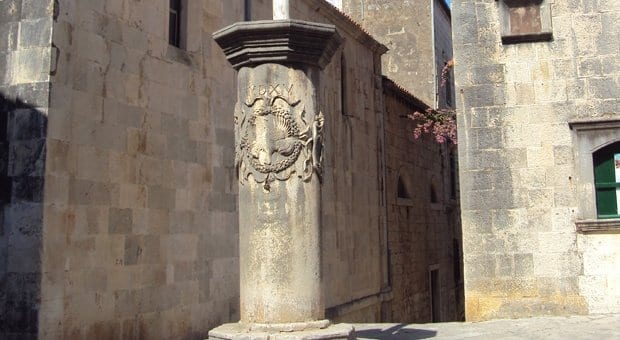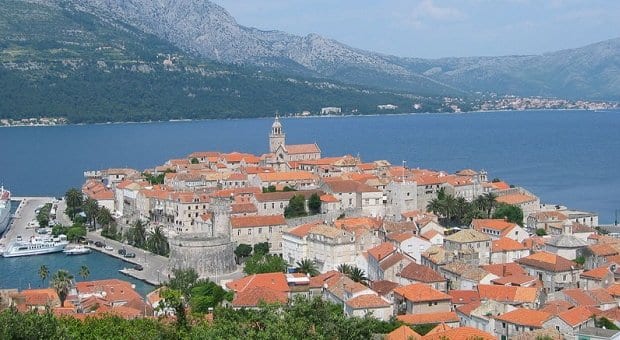
Town pillars adorned with old family arms date back to the 16th century. Credit: Chris Howson
One of the most beautiful sites in the Adriatic Sea is the island of Korula, the rumoured birthplace of famed explorer Marco Polo. Located just north of the Dalmatian Coast, Korula is home to some of the most popular tourist ports in Croatia.
According to legend, it was founded in the 12th century BCE and since then has proven a very hot piece of property. But considering that it has been captured and annexed more than two dozen times before finally landing in the hands of the Croatian people in the early 1990s, the island’s historic and prehistoric monuments remain remarkably unscathed. The oldest artifacts date back to the Mesolithic and Neolithic periods and were discovered at the archaeological site of Vela Spila. The finds are on display at the Centre for Culture in Vela Luka.
The island of Korula has no airport, so the easiest and most scenic way to get there is by ferry. Ships sail regularly from the mainland cities of Dubrovnik and Split to either the city of Korula on the eastern end of the island or the western port of Vela Luka. Before leaving for the island, decide which part you would like to see, as it is rather large. The two port cities lay 48 kilometres apart, which makes for a very expensive cab ride; buses between the cities are rare, and it is common for a scheduled bus not to show up.
The fastest route to the island, and the most popular choice for daytrips and excursions, is to the port of Korula. Like Dubrovnik, Korula’s old city is protected by thick stone walls, dating back to the Middle Ages. However, this city is most famous for a person and a piece of paper. Although there is no historic proof of the claim, it is local lore that famed explorer Marco Polo was born here to an established family of merchants. The city likes to cash in on this fable with plenty of tacky Marco Polo–themed stores and by offering tours of the house in which he is said to have been born. The piece of paper, however, carries a little more weight. In 1214, the City of Korula drafted its town statute, which prohibited slavery, making it the first place in the world to do so. Notable sites include the central Romanesque-Gothic Cathedral of Saint Mark, a Franciscan monastery and the southeastern Street of Thoughts, which is, notably, the only street in Korula without stairs. Outside the city walls the buildings are all relatively new, as construction outside the fortification was forbidden until the 18th century.
The inland city of Blato, which translates as “mud,” is one of the oldest settlements on the island, dating back to the fourth century. Located 40 kilometres northwest of the city of Korula, Blato can be quite a trek and is best accessed by bus or taxi. The route through the heart of the island makes it worthwhile, however. The main road of Smokvica takes you through thick Mediterranean pine forests and along breathtaking cliffs 500 metres above the sea. Although Blato does not have the seaside beaches or medieval walls of the city of Korula, it is the main destination for nightlife on the island.
Vela Luka sits at the western tip of the island and is the city of choice for island-hoppers and sun-worshippers, with its average 2,500 hours of sunny weather annually. Its port has frequent connections to the nearby Croatian islands of Hvar, Lastovo and Mljet. Prehistorically inclined visitors can see one of the most important Mesolithic cave dwellings in Europe. Vela Spila, which means “big cave,” sits several hundred metres above Vela Luka Bay and delivers a staggering picture of life for Mediterranean-dwelling humans 20,000 years ago.
Much like the rest of Croatia, and Eastern Europe for that matter, the island of Korula is not a place of openness as far as sexuality is concerned. Although Croatia’s laws forbid discrimination based on sexual orientation, the devout Catholic residents of the island wouldn’t think twice about casting an openly gay person out of their establishment. That being said, between the language barrier and already blurred lines of sexuality in Europe, as long as you are not making out with a member of the same sex in public, Croatians remain by and large none the wiser.
This is not to say that the island lacks a gay scene; you just have to look for it. Much like North Americans in the 1970s, Croatian citizens rely on subtle gestures and signals to meet other members of the queer community. If you are able to find a like-minded Korulan, there are parties, secret disco nights and outings to be had. The one place you’re guaranteed to find members of the queer community, of the local and tourist variety, is on one of the island’s numerous naturalist beaches. The island of Badija, just off the coast from the city of Korula,is home to one of the larger nudist beaches on Korula. Water taxis and shuttles leave from the city frequently and are dirt-cheap. Badija is also home to a 15th-century monastery that has been converted to a hotel if you wish to stay overnight. If you are staying on the other side of the island, Prozid is yet another small island off the coast of Vela Luka. Shuttles run infrequently and there is no place to spend the night, other than the forest, but it attracts a much younger crowd of tourists and island-hoppers.
When booking accommodations on the island, be sure to pay special attention to where on the island they are situated and what travel options are available to the nearest port. If possible, try to stay in either Vela Luka or the city of Korula; landing on the island to find you are stranded 40 kilometres from your hostel is a very stressful way to introduce yourself to Korula— and yes, I am speaking from experience.
For more information about Korula, visit korculainfo.com.

 Why you can trust Xtra
Why you can trust Xtra